The first session of traditional music course of Chinese ritual and music culture laboratory was successfully completed
Author:Source:bevictor伟德官网英文版 Time:2020-05-29Click:21
Return
On the afternoon of June 14, in room 115, building 7, college of humanities and law,our department invited Mr. Liu yiqiang, guzheng performance teacherand host of guangzhou radio and television station FM88.0, to hold a"guzheng aesthetic appreciation and analysis meeting" forus. This is the last lecture on traditional music of the school year.In addition to the teachers and students of the department of philosophy, Mr. Li hanhui took part in the lecture, as well as somemiddle-aged and elderly friends from outside the school who wereattracted to the lecture.This lecture takes "guzheng" asthe theme, telling about the historical evolution and development ofguzheng, and appreciating and playing the purpose of guzheng's music. At the beginning of the lecture, the teacher drew everyone intothe situation of appreciation and analysis with a sentence of "curved water flowing wine", thus leading the students to know theorigin of Chinese ethnic Musical Instruments and many ethnic MusicalIn struments. According to liu, the bone flute is the oldest ethnicin strument in China, with a history of up to 8,800 years. Bone flutesvary in size and pitch: the smaller the flute, the sharper the sound. Combined with the performance of "night of museum wonders",it shows the clear, round and desolate timbre of the bone flute.
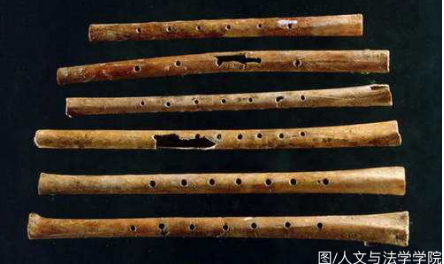
Teacher liu introduced the evolution of guzheng and the changes of different schools and versions of guzheng at home and abroad. The original body of guzheng is called qin zheng, which has a history of more than 2500years. In the long years of changes, the guzheng in the 20th century has derived several other whole schools on the basis of the north and south zheng, and its shape and structure has increased from theoriginal 13 strings in the tang and song dynasties to 16 strings, 18strings, 21 strings, etc. At present, the most commonly used specification is 21 strings.
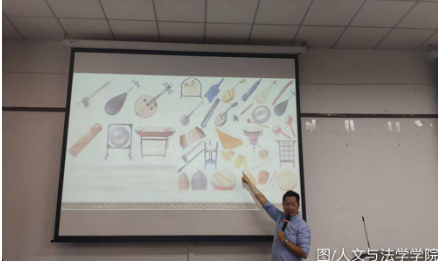
Teacher liu yiqiang explains ethnic Musical Instruments
Through pictures and videos, Mr. Liu shows the evolution and different shapesof "guzheng" in Korea, Japan and southeast Asian countries,as well as its modern combination with other western MusicalIn struments and singing methods. As early as last century, SouthKorea has subtly integrated gayageum with modern popular music,including rap, b-box, electronics, new age and a series of other musical styles. Ten years ago, Japan replayed Lady gaga's "Telephone"using shakuhachi, a combination of koto and street dance. In China,the film "girl of the shining light" combines the quadratic culture with traditional ethnic instruments, and popular bands suchas "girl's twelve" and "fanghua 18" combine folk music with modern pop. Under the impact of both hearing and vision,these innovations have combined the ancient and modern classical sounds at home and abroad, rejuvenating the guzheng and attracting people's attention and love for it again.

Teacherliu yiqiang performed live
In the appreciation of zheng music, Mr. Liu combined the technique ofsliding and trillage, and brought many famous guzheng songs solo foreveryone. "High mountains and flowing water" a, as if tounfold a picture of transcendent and peaceful natural landscape,leisurely and quiet feeling in the music, the millennium for peopleto be praised by the voice of the bosom friend to everyone broughtthe vibration of the soul. The elegant guzheng played the bright andgorgeous folk song "shandan blooming red" in northernshaanxi, which gave students a taste of the lithe and regional natureof the guzheng. "Lin 'an legacy" with heavy trill shows thetragic and stirring feelings of yue fei's wronged death; Comparedwith the softer "poppies", more glides are used to expressthe sorrow that li yu lost his life after the fall of the southerntang dynasty. The lecture ended with the famous guzheng song "fishingboat sings in the evening". According to the explanation, thissong was selected from the "night of spring, river, flowers andmoon" to become a single solo of guzheng. Its sound was deep andlong, which was once called by a foreign harpist as "a worldfamous song full of Oriental flavor" and adapted into a harptune.
In the interactive session, one of the students learned the playingtechnique of "the sea of laughter" in a few minutes.Teacher liu encouraged students who had never learned to play theChinese zither to try it. "thousand days of pipa, hundred daysof zither," she said. At the same time, the teacher alsostressed that when understanding any musical works, the first thingto do is to quote from the classics and understand the story behindthe composition, so as to better understand the meaning of thecomposition and obtain their own unique understanding.

At the end of the lecture, gao limei, on behalf of the teachers and students of the philosophy department, sincerely thanked li hanhui, liu yiqiang andother teachers for their dedicated appreciation of the series ofmusic art for the teachers and students of the philosophy department, assisted in the development and completion of the laboratory'straditional music courses, and offered great help and support to the ritual and music culture laboratory of the philosophy department,which was still in its initial stage. The lofty sentiments of all theteachers are demonstrating the noble and spiritual temperament of ar tbeyond the secular world. Mr. Gao expects you to cultivate your noblepersonality under the influence of the noble spirit of art and assumethe mission and responsibility of spreading excellent culture for thesociety.
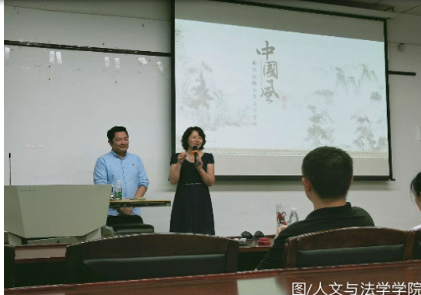
Teacher gao limei summed up the lecture
Thus, theone-year traditional music course of the philosophy class of 2017 wassuccessfully completed. Before and after this course, 8 lectures were organized, focusing on popularizing the knowledge of guqin, guzheng,erhu and other traditional Musical Instruments as well as music appreciation.

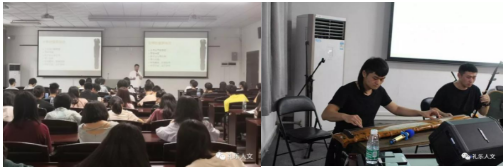
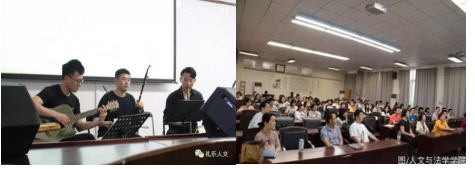
some Picturesof music lectures
Combining theoretical learning with music appreciation, the laboratory alsolaunched relevant practical courses. The lab invited guqin expert liuyonggang to carry out several practical exercises for the students,in which the students learned the basic fingering of guqin performance and learned to play a piece of music. Although theactivity space is small and the number of Musical Instruments islimited, students still take turns to practice the basic skills they have learned in the laboratory after class and record video assignments.
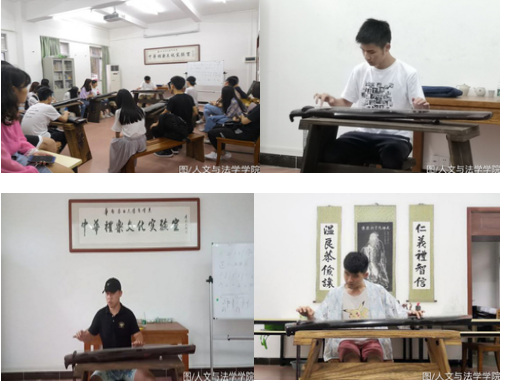
The guqinteacher, liu yonggang, guided the students to play on the spot
On May 4, 2019, with the help of teacher li hanhui, all the students of grade 2017 enjoyed the "2019 guangzhou folk orchestra's celebration of May Day and May 4 youth day -- the folk concert of huale lingnan". This group viewing, let the students more vivid and comprehensive experience the charm of folk music and cultural spirit.

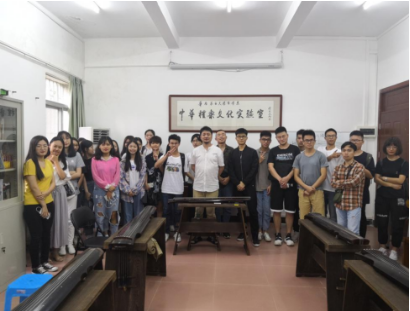
First issue over traditional music course, limited by class, to the study of traditional music is still at the preliminary understanding and the level of experience, but the sense of the course is that I hope the students can through understanding and appreciation of the Chinese traditional music, grasp the behind music of Chinese music culture spirit, which focus on practice learning Chinese culture, shape the cultural connotation of gentle personality temperament, become a rich humanistic accomplishment in a new era of talent. See you at the next wonderful event!
AUTHOR:PANHAIXUAN \ LUN CONGLIN \ LIN LI\ LUO XIAOXIN\WANGQIANMIN FROM:COLLEGEOF HUMANITIES AND LAW


